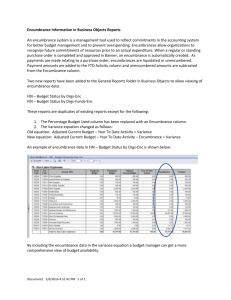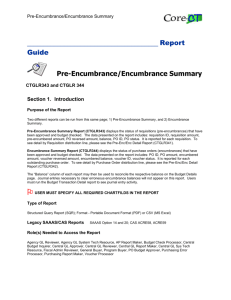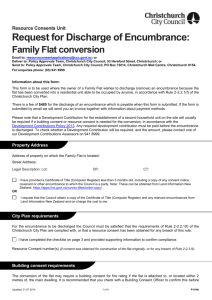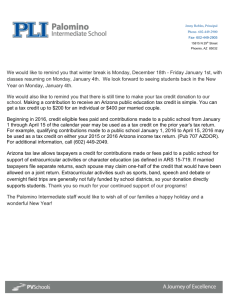Adobe Captivate
advertisement
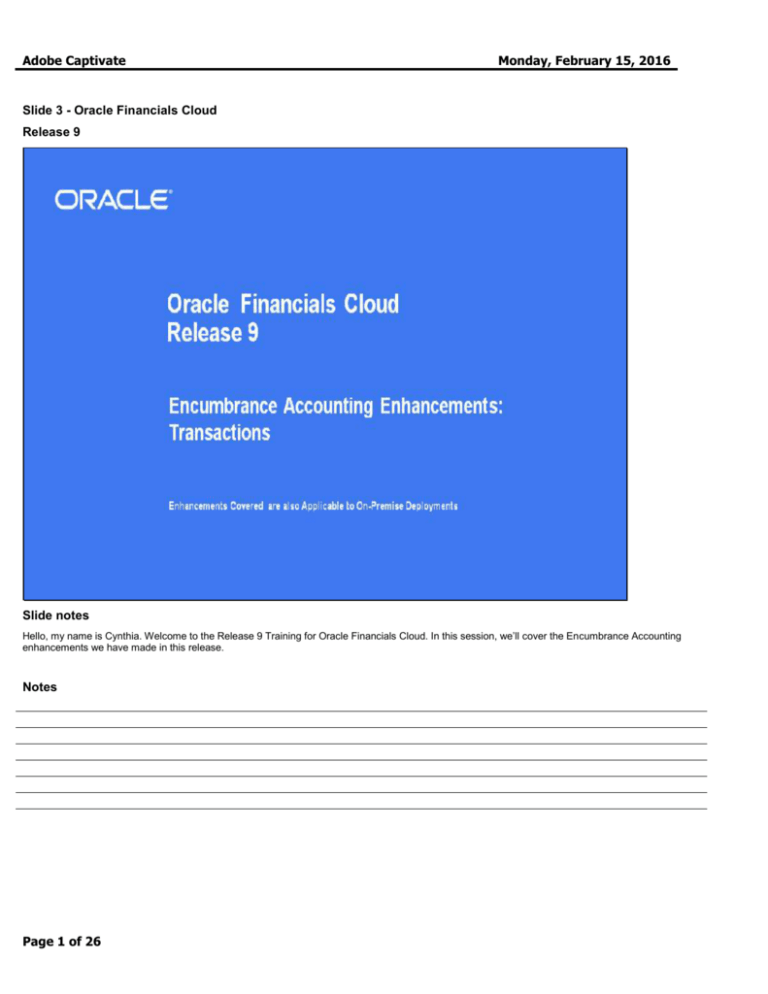
Adobe Captivate Monday, February 15, 2016 Slide 3 - Oracle Financials Cloud Release 9 Slide notes Hello, my name is Cynthia. Welcome to the Release 9 Training for Oracle Financials Cloud. In this session, we’ll cover the Encumbrance Accounting enhancements we have made in this release. Notes Page 1 of 26 Adobe Captivate Monday, February 15, 2016 Slide 4 - Agenda Slide notes For the enhancements covered in this training, we’ll give an overview, followed by more detail to explain how you can use them, and what business value they bring. Then we’ll walk you through a demonstration. Next we’ll explain what you need to consider before enabling these features in your business, and what you need to know to set them up. Notes Page 2 of 26 Adobe Captivate Monday, February 15, 2016 Slide 5 - Enhancements Overview Slide notes Oracle Fusion Financials now supports encumbrance accounting to help public sector organizations gain better visibility of commitments, obligations and expenditures to manage costs. Using encumbrance accounting, encumbrance journals are created throughout the procure to pay process, during requisitioning and purchasing—well in advance of the actual expenditure to forecast potential overspending. The encumbrance journals reclassify the transaction as it moves through the procure to pay process. In addition, you can manually enter encumbrance journal entries to record upcoming expenditures and adjustments. Notes Page 3 of 26 Adobe Captivate Monday, February 15, 2016 Slide 6 - Encumbrance Accounting in Subledgers Slide notes A new accounting method called ‘Accrual with Encumbrance Accounting’ is now available to you. This accounting method creates accounting for requisitions and purchase orders and the rest of the Procure to pay flow. Whereas the Standard Accrual accounting method creates journal entries for Invoices ONLY. When using the Accrual with Encumbrance Accounting Method, the following accounting will be created for a transaction: - When a requisition is approved and accounted, an encumbrance journal is created for the commitment. - When a requisition is converted to a purchase order and the purchase order is approved/opened and accounted, an encumbrance journal is created. The obligation for the purchase order is created and the commitment entry for the requisition is reversed. When an invoice is matched to the purchase order and the validated invoice is accounted, an encumbrance journal is created to reverse the obligation for the matched quantity of the purchase order. A journal entry for the invoice’s actual expense is also recorded which is the same accounting that would be created from the Standard Accrual Accounting Method. The journal entry for the payment of the invoice is also the same as the Standard Accrual Accounting Method. Page 4 of 26 Adobe Captivate Notes Page 5 of 26 Monday, February 15, 2016 Adobe Captivate Monday, February 15, 2016 Slide 7 - Encumbrance Subledger Journal - Requisition Slide notes The Create Accounting program creates commitment encumbrance journals for requisitions. The journals are created with the journal source of Purchasing and journal category of Requisition. The following types of requisition events will trigger accounting entries: Approval, Withdraw or cancel by the requestor and rejection by the buyer. The Approval event creates the commitment encumbrance. When a requestor withdraws or cancels the requisition or the buyer rejects the requisition, the commitment encumbrance created during the approval of the requisition is reversed. Page 6 of 26 Adobe Captivate Notes Page 7 of 26 Monday, February 15, 2016 Adobe Captivate Monday, February 15, 2016 Slide 8 - Encumbrance Subledger Journal - Purchase Order and Change Order Slide notes The Create Accounting program creates obligation encumbrance journals for purchase orders and change orders. Change orders are modifications to an implemented purchase order. The journals are created with the journal source of Purchasing and journal category of Purchase Order. The following types of Purchase order and change order events will trigger accounting entries: Approval Withdraw or cancel by the buyer rejection by supplier finally closing a purchase order or reopening the finally closed purchase order The Approval event creates the obligation encumbrance. If this purchase order was created from a requisition the commitment encumbrance is reclassified as an obligation encumbrance by reversing the commitment encumbrance. A change order creates an adjustment to the obligation encumbrance depending on the modification to the implemented purchase order. Page 8 of 26 Adobe Captivate Monday, February 15, 2016 When a buyer withdraws or cancels or the supplier rejects the purchase document, the obligation encumbrance created during the approval is reversed. The commitment encumbrance for the requisition is reestablished if the Purchase order has been approved but not implemented. When a purchase order is finally closed, the obligation encumbrance is reversed for the quantity of the purchase order that is still open. Reopening the finally closed purchase order reestablishes the obligation encumbrance amount from the final close. Notes Page 9 of 26 Adobe Captivate Monday, February 15, 2016 Slide 9 - Encumbrance Subledger Journal - Purchase Order Reversal Slide notes The Create Accounting program creates two journals when a standard invoice is matched to a purchase order. An encumbrance journal reverses the obligation encumbrance for the matched quantity of the purchase order. in addition, a journal is created for the invoice’s actual expense. Along with standard invoices, credit memos, debit memos and prepayment invoices will also create encumbrance journals related to the obligation. The journals are created with the journal source of Payables and journal category of Purchase Invoices., Credit Memos or Debit Memos depending on the type of Invoice transaction. When the process is run for uninvoiced receipt accruals two journals are also created. An encumbrance journal reverses the obligation encumbrance for the received quantity of the purchase order that has not been invoiced. An expense accrual for the quantity received is also created. The journals are created with the journal source of Receipt Accounting and the journal Category of period end accrual. The following types of events create encumbrance journals when an invoice is matched to a purchase order: validation, cancel and final match The Validation event creates the reversal of the obligation encumbrance for a standard invoice. When an invoice is cancelled, the obligation encumbrance is reinstated. When an invoice is marked as a final match to a purchase order, a final close of the purchase order is completed. The obligation encumbrance is reversed for the quantity of the purchase order that is still open. Page 10 of 26 Adobe Captivate Notes Page 11 of 26 Monday, February 15, 2016 Adobe Captivate Monday, February 15, 2016 Slide 10 - Create Accounting Slide notes Run the Create Accounting process in General Ledger to create accounting for requisitions and purchase orders using Purchasing’s Subledger Accounting process category of purchase requisition and purchase order, respectively. To create accounting for Payables invoices, run the Create Accounting process from either the Create Invoices page or the Create Accounting task available in the Invoicing workarea using the invoices process category. Notes Page 12 of 26 Adobe Captivate Monday, February 15, 2016 Slide 11 - Encumbrance Subledger Journals - Adjustments Slide notes Encumbrance adjustment journals can be manually created outside of the procurement process in General Ledger or in the Payables subledger. When creating the journal, you can classify the encumbrance balance by specifying the encumbrance type. Notes Page 13 of 26 Adobe Captivate Monday, February 15, 2016 Slide 12 - Encumbrance Accounting in Subledgers Slide notes Oracle Fusion Financials now supports encumbrance accounting to help public sector organizations gain better visibility of commitments, obligations and expenditures to manage costs. Using encumbrance accounting, you can record encumbrance journals throughout your procure to pay process, such as during requisitioning and purchasing—well in advance of the actual expenditure to forecast potential overspending. General Ledger and Subledger Accounting fully support encumbrance journals in various processes as well as in inquiry, reporting and year end carry forward. Notes Page 14 of 26 Adobe Captivate Monday, February 15, 2016 Slide 18 - Summary of Enhancement Capabilities Slide notes Here is the summary of the features I have talked about today. The Create Accounting process creates encumbrance journals during requisitioning and purchasing, which reclassifies the transaction through out the procure to pay flow. This allows your organizations gain better visibility of commitments, obligations and expenditures to manage costs. You also can manually enter encumbrance journal entries to record upcoming expenditures and adjustments. Notes Page 15 of 26 Adobe Captivate Monday, February 15, 2016 Slide 19 - Implementation Advice Slide notes So that concludes the audio portion of this presentation, thank you for listening. There is no audio in the implementation advice section. You can easily pause and rewind any of these slides if you require additional time to take in the detail. Notes Page 16 of 26 Adobe Captivate Slide 20 - Feature Impact Guidelines Slide notes Notes Page 17 of 26 Monday, February 15, 2016 Adobe Captivate Slide 21 - Setup Summary Slide notes Notes Page 18 of 26 Monday, February 15, 2016 Adobe Captivate Slide 22 - Manage Encumbrance Accounting Slide notes Notes Page 19 of 26 Monday, February 15, 2016 Adobe Captivate Slide 23 - Subledger Accounting Method – Payables Slide notes Notes Page 20 of 26 Monday, February 15, 2016 Adobe Captivate Slide 24 - Subledger Accounting Method – Purchasing Slide notes Notes Page 21 of 26 Monday, February 15, 2016 Adobe Captivate Slide 25 - Subledger Accounting Method – Receipt Accounting Slide notes Notes Page 22 of 26 Monday, February 15, 2016 Adobe Captivate Slide 26 - Specify Ledger Slide notes Notes Page 23 of 26 Monday, February 15, 2016 Adobe Captivate Slide 27 - Manage Encumbrance Types Slide notes Notes Page 24 of 26 Monday, February 15, 2016 Adobe Captivate Slide 28 - Job Roles & Associated Duty Roles Slide notes Notes Page 25 of 26 Monday, February 15, 2016 Adobe Captivate Slide 29 - Associated Release Training Slide notes Notes Page 26 of 26 Monday, February 15, 2016
